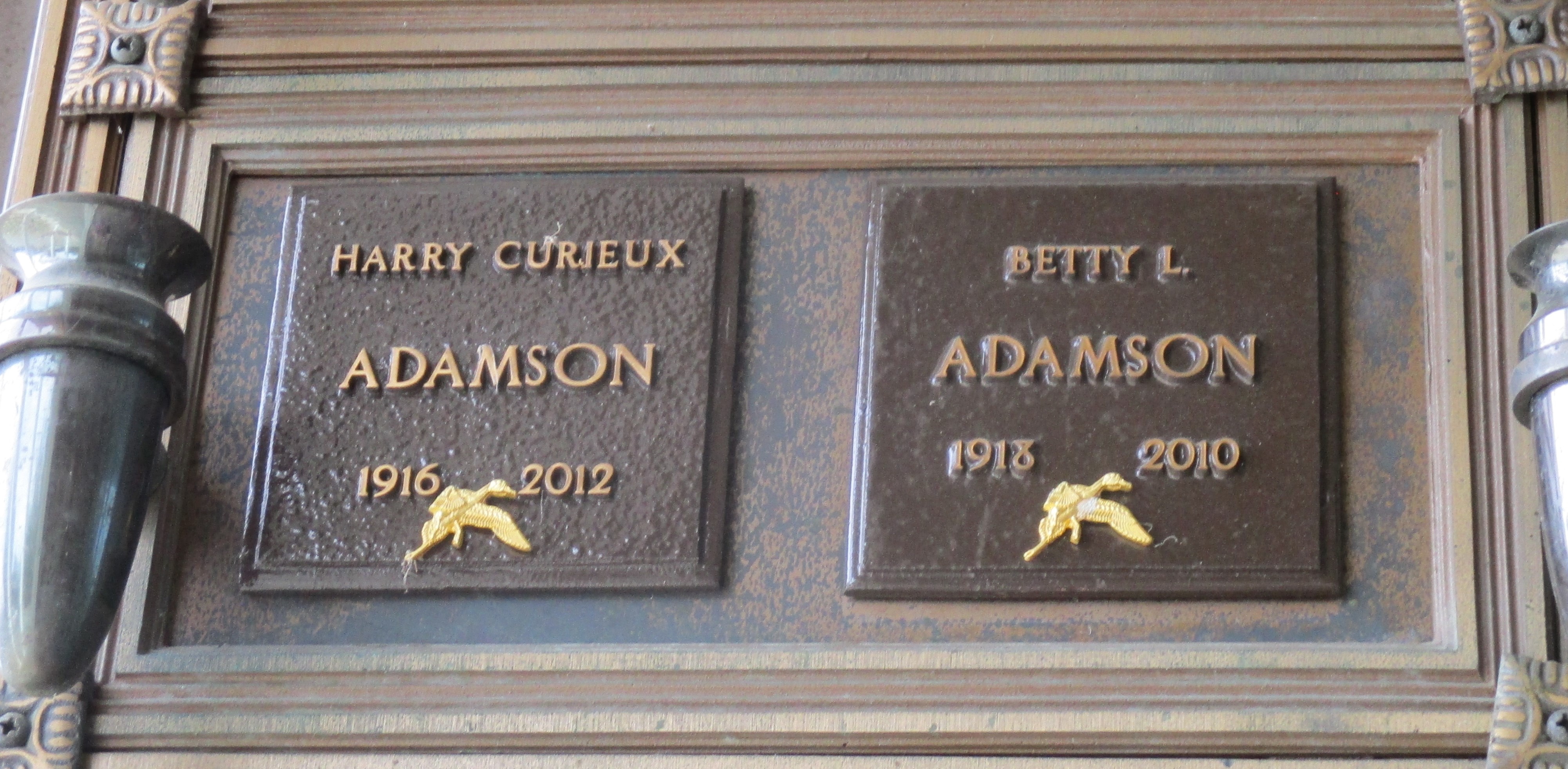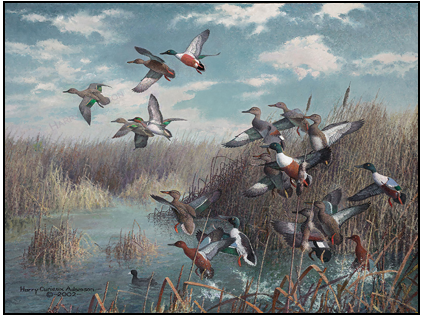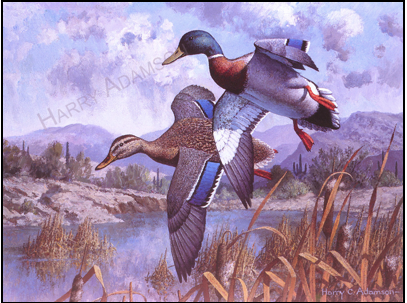November 14, 1916 to April 22, 2012
By Katharine Blossom Lowrie
A wildlife artist known to bird lovers everywhere
Harry Curieux Adamson—a wildlife artist who spent his life traipsing after the waterfowl he so majestically captured on canvas—passed away at home in Woodland, CA on Sunday, April 22, 2012. He was 95.
Adamson painted to the end, even after he no longer packed up to travel the world in search of a migration of snow geese or gathering of pink-eared mallards.
A familiar sight in his California Waterfowl Association jacket and WW II veteran's cap, the folksy, fair-haired artist with the ready sense of humor was known to bird lovers everywhere. He was that rare breed who raised millions for wildlife conservation and refused to hunt.
A flurry of Wigeon ducks
With his wife, Betty, at his side, he would spend hours in a duck blind, waiting for the rush of inspiration that informed his singular art—whether the ultimate result was a pair of stately Canadian geese escorting their young through a weedy marsh or a flurry of Wigeon ducks careening down from the heavens.
Born November 14, 1916 in Seattle, WA, Adamson, one of three children, was the second son of Harry E. and Augusta Adamson. The family settled on a four-acre farm just east of Hayward, CA, where young Harry grew up with 500 chickens and 200 apricot trees. He collected snakes and found he loved to draw and paint.
Following Edwin Markham Elementary and high school in Hayward, Adamson served in the U.S. Army during WWII. He later studied under Paul J. Fair, a nationally recognized sculptor and wildlife photographer, and illustrated books on mammals at the Museum of Vertebrate Zoology in Berkeley, California.
It was on a hike with the Berkeley Hiking Club in 1941 that Adamson met his future bride, Elisabeth Louise (Betty) Liebhard of Minnesota.
The two nature-lovers got acquainted over milk shakes and were married on October 8, 1944, when Adamson was on leave from the Army. He served 4-1/2 years as a sergeant, crossing the Rhine and seeing combat with General George S. Patton.
Awash with flocks of waterfowl
Following his service in World War II, Adamson pursued his art full-time, traveling to exotic locales and painting lush landscapes awash with flocks of waterfowl. Gradually his work found wider acceptance, and in 1952 a painting of pintail ducks was purchased by the then President of Mexico, Miguel Aleman Valdez.
Although Adamson occasionally painted the bighorn sheep, condors, and tropical birds he encountered on his travels, his emphasis was always on waterfowl, a fascination that led him to observe one hundred sixteen species of ducks and geese in the wild.
Described by internationally famous wildlife artist David Maass as "unsurpassed when it comes to portrayals of wildfowl on the wing in their natural surroundings," Adamson was called "one of the finest waterfowl artists in the world" by noted artist Owen Gromme.
Much of Adamson's success was due to his wife, Betty, who provided vital encouragement, along with all the creature comforts in their home in Lafayette, CA, where books on wildlife crowded the shelves and paintings and prints lined the walls, including an Ansel Adams' photograph of Yosemite.
Traveling on all seven continents
The couple spent 65 years together, traveling to countries on all seven continents, their wanderlust fueled by their mutual fascination with other cultures and native wildlife. But reaching secluded waterfowl habitats often took them off the beaten path.
On one trip to the Australian outback, for example, their car got stuck in the sand and they had to hike miles to the highway, where strangers rescued them with "You ‘right, mates?"
And on an island off Brazil (one of the few times Betty stayed behind due to illness) Adamson and his party were walking through a marsh, when—alert to area crocodiles—they mistook a giant anaconda for a footpath through the weeds.
As a bemused Adamson later told his wife, the snake was full of food "and not interested in moving" … or eating birdwatchers.
The artist, who numbered the skunk among his favorite animals and envisioned his grave marker decorated with a pintail duck, balanced an even temperament with a wicked sense of humor. One of his favorite sayings was "To lift a glass … to sin and corruption."
Although the Adamsons had no children, the couple adored their Clancy, an Irish Setter/Collie mix ultimately laid to rest in Betty's precious rose garden in Lafayette.
Championed his art
Not only did Betty Adamson, who passed away of cancer in 2010, love gardening, cooking and canning fruit, she managed her husband's art studio, championed his art and made many a campsite warm and cozy.
In 2008, the California Waterfowl Association presented Betty with their Artemis Award for her help in preserving California's outdoor heritage.
"She was always there," Adamson said of his late wife, always ready with food and drink. He wished he had told her more often "how great it was" to travel the world with her.
But the gregarious artist was also a terrible flirt (his "worst fault," he once joked), especially with his nurses at the Woodland Nursing Inn, where he lived for some time after his wife's passing.
Adamson's paintings have been exhibited to wide acclaim, nationally and internationally, including in the prestigious "Birds in Art" and "Animals in Art" exhibitions, as well as at the Smithsonian Art Museum in Washington D.C., the British Museum in London and the Carnegie Museum of Natural History in Pittsburgh.
Blue Wing Fine Art Gallery
But the true home for Adamson's paintings and Giclée prints has long been the Blue Wing Fine Art Gallery in Woodland, CA. Gallery owner Al Eby was not only one of Adamson's closest friends, he was chosen as the trustee for the artist's estate.
During his lifetime, Adamson, a founding member of the Mt. Diablo Audubon Society, donated paintings and prints worth close to three million dollars to raise money for conservation causes. He was named the first California Waterfowl Association Artist of the Year and 1979 Ducks Unlimited Artist of the Year.
Harry Adamson is survived by a brother, Charles (Bud) Adamson, a sister, Hermine A. Pearce and a number of lively nieces and nephews.
Adamson was laid to rest next to his wife at Oakmont Memorial Park, 2099 Reliez Valley Road, Lafayette, CA 94549.
For more information about this wonderful artist and his work, contact Al Eby at the Blue Wing Fine Art Gallery 405 Main St., Woodland, CA 95695 or email him at [email protected].
November 14, 1916 to April 22, 2012
By Katharine Blossom Lowrie
A wildlife artist known to bird lovers everywhere
Harry Curieux Adamson—a wildlife artist who spent his life traipsing after the waterfowl he so majestically captured on canvas—passed away at home in Woodland, CA on Sunday, April 22, 2012. He was 95.
Adamson painted to the end, even after he no longer packed up to travel the world in search of a migration of snow geese or gathering of pink-eared mallards.
A familiar sight in his California Waterfowl Association jacket and WW II veteran's cap, the folksy, fair-haired artist with the ready sense of humor was known to bird lovers everywhere. He was that rare breed who raised millions for wildlife conservation and refused to hunt.
A flurry of Wigeon ducks
With his wife, Betty, at his side, he would spend hours in a duck blind, waiting for the rush of inspiration that informed his singular art—whether the ultimate result was a pair of stately Canadian geese escorting their young through a weedy marsh or a flurry of Wigeon ducks careening down from the heavens.
Born November 14, 1916 in Seattle, WA, Adamson, one of three children, was the second son of Harry E. and Augusta Adamson. The family settled on a four-acre farm just east of Hayward, CA, where young Harry grew up with 500 chickens and 200 apricot trees. He collected snakes and found he loved to draw and paint.
Following Edwin Markham Elementary and high school in Hayward, Adamson served in the U.S. Army during WWII. He later studied under Paul J. Fair, a nationally recognized sculptor and wildlife photographer, and illustrated books on mammals at the Museum of Vertebrate Zoology in Berkeley, California.
It was on a hike with the Berkeley Hiking Club in 1941 that Adamson met his future bride, Elisabeth Louise (Betty) Liebhard of Minnesota.
The two nature-lovers got acquainted over milk shakes and were married on October 8, 1944, when Adamson was on leave from the Army. He served 4-1/2 years as a sergeant, crossing the Rhine and seeing combat with General George S. Patton.
Awash with flocks of waterfowl
Following his service in World War II, Adamson pursued his art full-time, traveling to exotic locales and painting lush landscapes awash with flocks of waterfowl. Gradually his work found wider acceptance, and in 1952 a painting of pintail ducks was purchased by the then President of Mexico, Miguel Aleman Valdez.
Although Adamson occasionally painted the bighorn sheep, condors, and tropical birds he encountered on his travels, his emphasis was always on waterfowl, a fascination that led him to observe one hundred sixteen species of ducks and geese in the wild.
Described by internationally famous wildlife artist David Maass as "unsurpassed when it comes to portrayals of wildfowl on the wing in their natural surroundings," Adamson was called "one of the finest waterfowl artists in the world" by noted artist Owen Gromme.
Much of Adamson's success was due to his wife, Betty, who provided vital encouragement, along with all the creature comforts in their home in Lafayette, CA, where books on wildlife crowded the shelves and paintings and prints lined the walls, including an Ansel Adams' photograph of Yosemite.
Traveling on all seven continents
The couple spent 65 years together, traveling to countries on all seven continents, their wanderlust fueled by their mutual fascination with other cultures and native wildlife. But reaching secluded waterfowl habitats often took them off the beaten path.
On one trip to the Australian outback, for example, their car got stuck in the sand and they had to hike miles to the highway, where strangers rescued them with "You ‘right, mates?"
And on an island off Brazil (one of the few times Betty stayed behind due to illness) Adamson and his party were walking through a marsh, when—alert to area crocodiles—they mistook a giant anaconda for a footpath through the weeds.
As a bemused Adamson later told his wife, the snake was full of food "and not interested in moving" … or eating birdwatchers.
The artist, who numbered the skunk among his favorite animals and envisioned his grave marker decorated with a pintail duck, balanced an even temperament with a wicked sense of humor. One of his favorite sayings was "To lift a glass … to sin and corruption."
Although the Adamsons had no children, the couple adored their Clancy, an Irish Setter/Collie mix ultimately laid to rest in Betty's precious rose garden in Lafayette.
Championed his art
Not only did Betty Adamson, who passed away of cancer in 2010, love gardening, cooking and canning fruit, she managed her husband's art studio, championed his art and made many a campsite warm and cozy.
In 2008, the California Waterfowl Association presented Betty with their Artemis Award for her help in preserving California's outdoor heritage.
"She was always there," Adamson said of his late wife, always ready with food and drink. He wished he had told her more often "how great it was" to travel the world with her.
But the gregarious artist was also a terrible flirt (his "worst fault," he once joked), especially with his nurses at the Woodland Nursing Inn, where he lived for some time after his wife's passing.
Adamson's paintings have been exhibited to wide acclaim, nationally and internationally, including in the prestigious "Birds in Art" and "Animals in Art" exhibitions, as well as at the Smithsonian Art Museum in Washington D.C., the British Museum in London and the Carnegie Museum of Natural History in Pittsburgh.
Blue Wing Fine Art Gallery
But the true home for Adamson's paintings and Giclée prints has long been the Blue Wing Fine Art Gallery in Woodland, CA. Gallery owner Al Eby was not only one of Adamson's closest friends, he was chosen as the trustee for the artist's estate.
During his lifetime, Adamson, a founding member of the Mt. Diablo Audubon Society, donated paintings and prints worth close to three million dollars to raise money for conservation causes. He was named the first California Waterfowl Association Artist of the Year and 1979 Ducks Unlimited Artist of the Year.
Harry Adamson is survived by a brother, Charles (Bud) Adamson, a sister, Hermine A. Pearce and a number of lively nieces and nephews.
Adamson was laid to rest next to his wife at Oakmont Memorial Park, 2099 Reliez Valley Road, Lafayette, CA 94549.
For more information about this wonderful artist and his work, contact Al Eby at the Blue Wing Fine Art Gallery 405 Main St., Woodland, CA 95695 or email him at [email protected].
Family Members
Sponsored by Ancestry
Advertisement
Explore more
Sponsored by Ancestry
Advertisement








